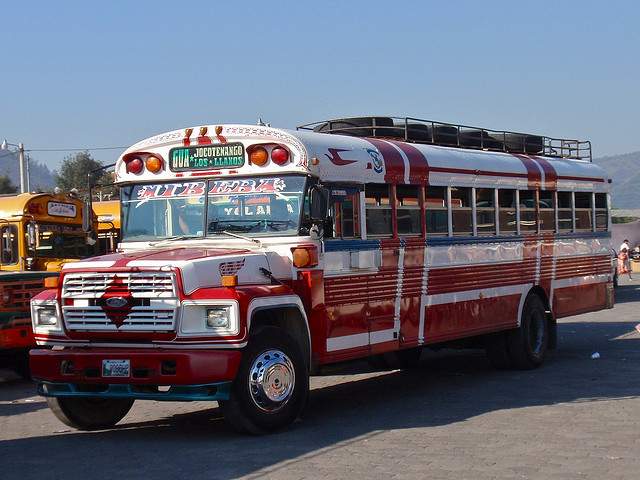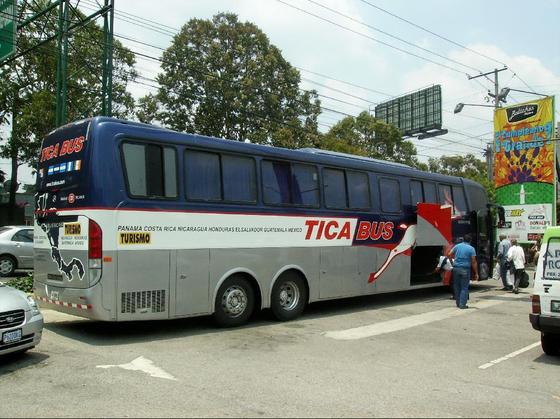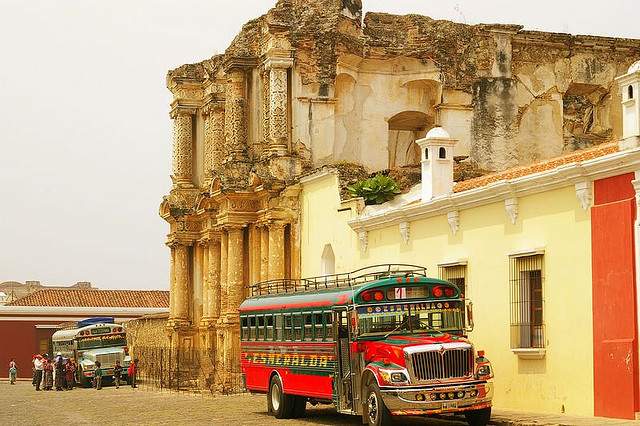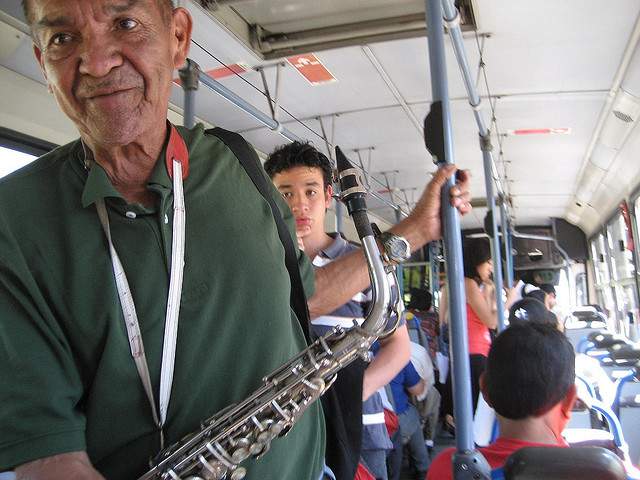A land of deep, steamy jungles full of exotic wildlife, white sand beaches, smoking volcanoes, clear ocean waters, amazing surf and plenty of delicious food all at an amazingly inexpensive prices, Central America is a dream backpacker/budget traveler destination.
Not only will you be able to see and experience amazing scenery and cultures, but you can also eat huge plates of beans, rice and chicken for less than $3 and find a place to sleep for less than $10. Palm fringed beaches and delicious meals for under $5? Sounds like my version of paradise.
While many Central American countries experienced decades of civil unrest, military dictatorships and violent civil war in the past, there are currently no armed conflicts in Central America, which has made traveling in and through these countries much safer and easier than it was in the past. While you still should exercise caution (and keep your valuables hidden or securely on you), traveling around Central America via public transportation is definitely not only a cheap way to get around, but also a safe one.
[social]
Because far fewer people own cars in Central America compared to their neighbors to the north, bus travel is an important and integral form of transportation not only for travelers, but also for locals. While it is not always fastest or most comfortable way to get around, it definitely provides a travel experience all in itself. If you want to see scenery from high above through an airplane window or fast moving tour bus, then local bus travel is probably not for you. However, if you want to be surrounded by the local culture on all sides (sometimes even sharing a bus with chickens as passengers), these buses are definitely the way to go.
As many locals use buses as a primary form of transportation (and when traveling it’s always good to do as the locals do), bus travel in Central America can not only be a cheap way to get from Point A to Point B, but will also enhance your travel experience. Some of my favorite stories from my month-long trip through Panama last summer happened on the long bus rides we took. With a little patience, some preparation and a readiness for confusion and/or the unexpected, bus travel is a great way to get around Central America.
Tour/Tourist Buses versus Local Buses
While it is much safer to travel through Central America today than it was a decade ago, there are definitely still instances of robbery and highjackings today (though these are rare for the most part). Traveling by local bus rather than larger tourist buses can actually be safer because you are traveling with locals rather than “rich” tourists—making it far less likely to have the whole bus stopped and robbed by highway men.
Types of Buses
Although bus travel varies slightly from country to country in Central America, it is fairly uniform from Mexico to Panama. Here is a run-down on the three main types of buses you will find in Central America:
International Buses
The international travel route leads mostly on the Pacific (west) side of Central America, along the Pan-American highway. You should check specifically where it is safe to take a bus across borders and be prepared for delays on the borders when you will have your passport checked and you may have to pay an entrance fee.
The Pan American highway starts south in Panama City, crosses on the Pacific side into Costa Rica, passes by San Jose crosses again at the Pacific coast into Nicaragua. It is possible to cross the Costa Rican / Panamanian border at the Caribbean coast but it takes longer and the border is just open during the day. Between Costa Rica and Nicaragua are two official borders. The more frequented one is “Penas Blancas” at the Pacific side and the other one is between Los Chiles and San Carlos, Nicaragua.
Between Nicaragua and Honduras exist three border-crossings. Honduras and El Salvadorshare various border-crossings as well as Honduras and Gautemala and El Salvador and Guatemala.
If you are traveling overland from Mexico, it can be tricky to cross the border via bus into Guatemala.
Tica Bus and King Quality buses run long distance routes from Panama City to Mexico.
Coach or “Luxury” Buses
I put luxury in quotation marks because this is definitely a relative term. These buses tend to be larger, coach-type buses (think Greyhound) and tend to be the buses used on longer trips. As a budget traveler in Panama (my friend and I were on about a $20/day budget), we hesitated before getting on any form of transportation that had the word “luxury” associated with it. However, while these buses are certainly luxurious compared to some of the local chicken buses or guagas you will find in Central America, they are certainly affordable.
You will often find these coach-style buses on longer journeys and/or on international trips (like from Panama to Costa Rica for example). Most of these coach-style buses are modern and air-conditioned with fairly comfortable seats (if you are lucky you’ll even get one that reclines). Some even have televisions that will play budget music videos and/or dubbed American movies to temper the longer journeys.
Inter-City Buses
When traveling shorter distances or between two non-hub cities or towns in Central America you will often find these smaller, less comfortable buses. In much of Latin America, these bus lines are served by Toyota Coasters, which are kind of a cross between an obese passenger van and a squashed bus. They tend to connect most towns and cities to each other and to major hub cities (capitals like Panama City, San Jose, and Tegucigalpa etc.).
I never ceased to be amazed at the number of people that could be crammed onto these buses. Don’t even begin to think that if every seat is full the bus will not continue to stop and pick up more people. In fact, these buses keep collecting passengers until every seat, aisle and lap is full. Extra folding seats seem to come out of every spare spot and be prepared to have them throw your backpack on the roof (I always wondered if I’d ever see my backpack again, but it always seemed to make the journey).
Local Buses (Guagas, Chicken Buses and Diablo Rojos)
These buses usually serve as the mode of transportation for intra-city and intra-town travel, though you will also see these buses serving routes between smaller cities and towns in many countries.
These buses are sometimes called “Diablo Rojos” (Red Devils) and are usually refurbished American school buses that are outlandishly painted and covered in murals (which sometimes feature bad renderings of semi-naked women and/or cartoonish versions of Jesus). While these are certainly not the most comfortable mode of transportation, they certainly do the trick.
Tips for Bus Travel in Central America
1. Understand you will probably stand out
When traveling in Panama I invented a new verb: to freakshow. This is what my travel partner and I did across most of Central America. We were white; females and traveling with big backpacks on—all things which would make you stand out on their own in Central America. Combine them, and we got a lot of looks, especially in smaller communities not accustomed to seeing many tourists, the stares we would get made it clear we were not a normal sight in Panama. Lindsey and I freakshowed our way around Panama. But it was fine. Yes, we had a man with a pair of women’s panties hanging from his back pocket come talk to us on the bus. Yes, we were once surrounded by local boys on a dock while waiting for a boat taxi who called us “sweet as white sugar,” but that’s ok. Accept the fact you’ll get stares and stand out.
We were often the only foreign travelers on the “chicken buses.” You will stand out. You will get stared at. You will get approached and hassled for tips and money (the assumption is that if you are a gringo you are loaded). Accept it as part of the experience.
2. Redefine your idea of personal space
As a fourth person slides next to you (on a seat made for 2) with a child on her lap and an enormous sack of potatoes in the aisle, you’ll start to realize what you are in for. Buses in Central America will rarely leave someone on the roadside, even when the bus is seemingly already full. There always seems to be room for a few more. While making this kind of full-body contact wouldn’t fly in the U.S., this is definitely acceptable in Central America. Accept the fact that you’ll be crammed into these buses and sitting on top of perfect strangers.
If you are lucky enough to get on the bus early on, try to grab a window seat. Not only will this allow you to see the countryside pass by outside (which is often stunning), but you’ll also only have people crammed up next to you on one side.
3. Ask for Help/Make Friends with the Ayudante
My Spanish is not great. I can say “no comprendo, “una cerveza,” “cuanto?” and then my Spanish skills pretty much end there. This did not stop me from getting around Central America successfully on the bus. Don’t hesitate to ask someone where the bus is going. If you can’t put together a full sentence, repeating the name of where you are trying to go usually gets the point across just fine and someone will point you in the right direction.
There will be a man who stands by the front door of most buses in Central America called an ayudante (I say man because I never once saw a woman doing this job). It is his job to collect fares, cram people on the bus, and handle the luggage (which sometimes means you’ll have him put someone else’s bag on your lap). I was always amazed that he seemed to not only remember how long each passenger had been riding (which determines the fare), but also which bags belonged to whom.
4. Tell the Ayudante where you want to get off
As you’d imagine, it’s also important to know where you are getting off. Since I always found it impossible to understand anything the ayudante was saying over the chatter and blasting salsa music, I would always make sure to tell him where I wanted to get off as soon as I stepped on the bus. Then I would stay seated stop after stop until the man would look right at me (remember, I stood out) and would say “hola chica”. This way I knew I was getting off in the right spot. It’s usually pretty obvious you aren’t a local, so people on the bus tend to be helpful in making sure you get where you are trying to go.
5. Accept the fact that there is no system
I spent the better part of a month trying to figure out the system the buses used for knowing when to pick up/drop off people until I finally came to the conclusion that there is no real system. There are no bus stops, per se. People just stand on the side of the road and wave their arms to get on the bus and holler when they want to get off.
Most buses also don’t run on a strict schedule, so it can be a crap shoot knowing when a bus will come by sometimes. In much of Central America, buses work on a decentralized system in which a liscense is issued for a route and then driver’s purchase and maintain their own bus. Sometimes several routes and buses are license by one operator who then hires several driver/conductor teams. Because there is no real centralized system, however, the system can vary from place to place, route to route, which can be confusing for the outsider traveler. Accept this and go with the flow.
6. You will be overwhelmed
Anytime I found myself in a large bus terminal in Central America, I inevitably would end up confused, overwhelmed and not entirely sure where I needed to go. Because buses are a main mode of transportation for so many people in Central America, bus terminals like the Albrook Bus Terminal in Panama City tend to be packed and hectic. It can be difficult to figure out which bus leaves when and where it goes. Take a deep breath, don’t be afraid to ask for help and expect to feel a little confused.
I found that people were almost always helpful in helping point you the right direction in Central America. Even if your Spanish skills aren’t great, don’t be afraid to simply repeat the name of where you are trying to go. With a little patience you’ll eventually get on the right bus.
7. You usually pay when you get off
While this is not always true on the bigger coach-style buses that travel longer distances (you often buy these tickets at the bus terminal before departure), you will almost always pay your bus fare when you get off the bus. Bus fares will depend on where you got on and where you get off the bus. The ayudante amazingly seems to know when everyone got on the bus and how much to charge them. Have cash handy (the smaller the bills the better) and be ready to pay when you arrive at your destination.
Read more about bus travel and travel in Latin America:
- 7 Spectacular Bus Routes Through South America
- How to Travel Long Distance by Bus
- Central America on $25 a Day
Photo Credits: John Pavelka, J. Stephen Conn, Adam Baker, LShave, happysleepy




